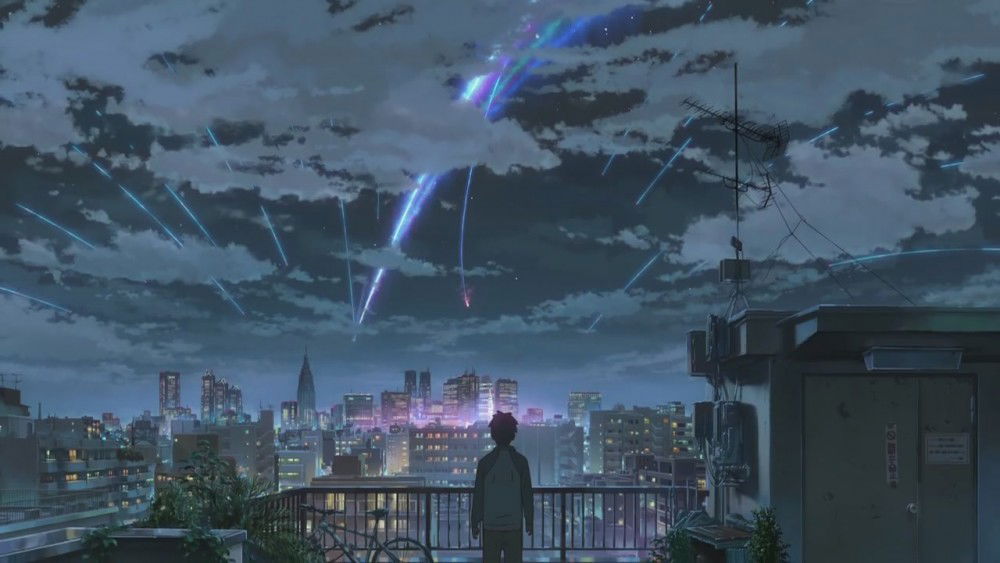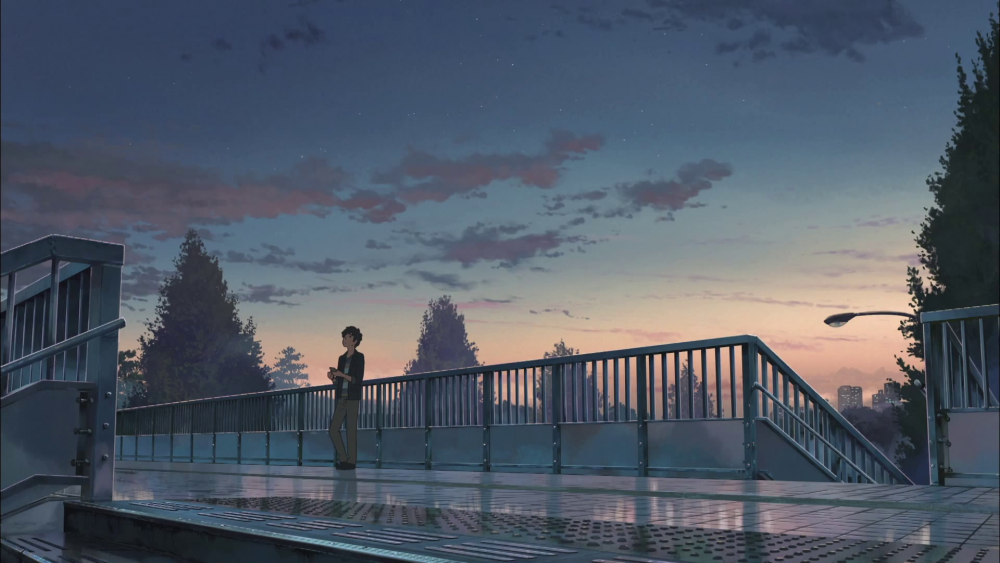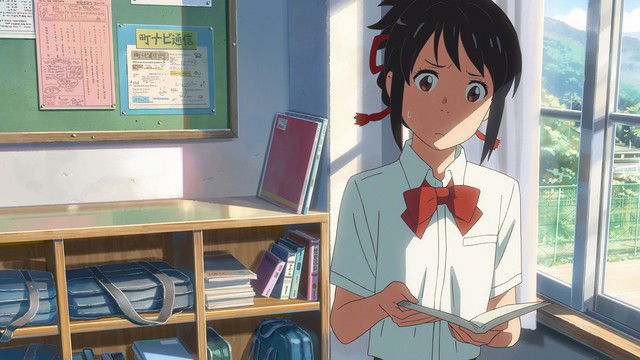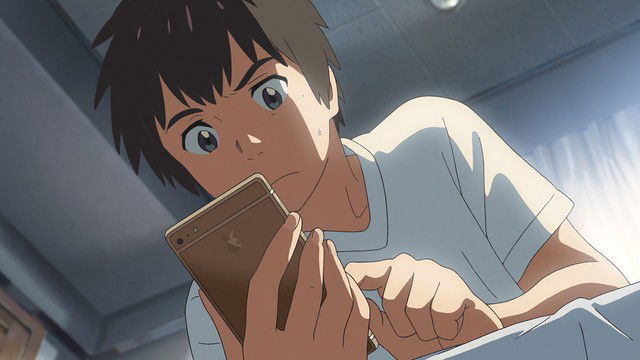Anyone who knows me knows that Makoto Shinkai is my favorite director in anime. So much so that I even took the time to review every single one of his works. There was a time that I thought he was done with creating movies. He seemed more interested in producing animated shorts, tv commercials, or slightly longer single episodes of anime. Then, late last year, it was announced that Makoto Shinkai was making a brand new feature film called Kimi no Na wa (Your Name). I didn’t care what it was about, all I knew was that it was from my favorite director and I wanted to watch it. When the movie came out, it was received with high regards by the anime community at Anime Expo in Los Angeles, California. Then, it caught on like wildfire and earned some tremendous accolades (and continues to earn them even at the time this review is being written.)
As with any Makoto Shinkai/CoMix Wave production, I felt that it would be an injustice to watch this film in anything less than 1080p, but the hype and the pressure of waiting got to me and I watched the 480p DVD Hard Sub. Did Kimi no Na wa live up to the hype? Does it deserve all of the accolades it has gotten? Was it worth jumping the gun and watching this film in borderline potato quality? I’m about to answer all of those questions with this review!
Let’s go!
The Story
The story seemed rather convoluted at first, but then I found a way to summarize it so that some who haven’t watched the movie can understand what they are getting into. If you have seen the American movie Frequency, you’ll know what to (sort of) expect with Kimi no Na wa. If you haven’t seen Frequency (and I suggest that you do because it is a pretty good movie), then Kimi no Na wa follows two people: a boy named Taki and a girl named Mitsuha.
By some strange cosmic event, involving the passing of Comet Tiamat, when these two go to sleep there is a random chance that they will switch bodies. At first, like anyone, they have no idea what is going on until, one day, Mitsuha, while in Taki’s body, discovers that he keeps a journal on his cell phone. She writes an entry in there and when they switch back, Taki realizes that this is how they can communicate with each other. Each time they swap, which is several times per week, they keep leaving each other messages in their phones. Sometimes they take liberties while in each other’s bodies and cause a bit of trouble, such as when Mitsuha set up a date for Taki with his co-worker, whom he’s had a crush on.
While this is the basis for the first half of the film, I dabbled in whether or not I should talk about the second half. Doing so would reveal HUGE spoilers for the film, but it’s the part of the film that draws out the biggest and deepest emotions from the viewer. I came to the conclusion that I don’t believe I would be happy with myself if I didn’t talk about the second half so I am going to do that. If you’ve seen the movie and wish to know my thoughts, then please continue on. For those who do not wish to be spoiled, skip past the section with the spoiler tags for my spoiler-free summary of the film. If you read between the tags and didn’t want to be spoiled, then all I can say is I gave you good warning.
The back half of the film has Taki wanting to meet Mitsuha. The only clues to her whereabouts is the scenery he remembers from when they switched bodies. Taki is a tremendous artist and he uses that talent to draw the town he saw when he stood on a ridge overlooking it. Miki Okudera, his crush, and Tsutomu Fujii, his co-worker and friend, accompany him on his search for Mitsuha. They ride train after train in hopes of finding a clue as to where Mitsuha lives. It isn’t until they stop at a diner when a chef recognizes the town that Taki drew. The town goes by the name Itomori and when he asked if it was far away from there, that’s when the bomb gets dropped on us.
Itomori was destroyed by a fragment of Comet Tiamat three years ago. 500 people, including Mitsuha, died in the impact. With this revelation, Taki has been switching bodies with Mitsuha three years in her past. This also causes Taki to begin to forget Mitsuha’s name with the only thing guiding him forward is a nagging impulse that he should be searching for someone. Taki remembers the shrine that he visited in Mitsuha’s body and rushes there to find the jug of sake that Mitsuha and her sister left there. He drinks the sake and experiences a flood of memories. This interaction, along with seeing a depiction of the comet in “cave art” on the ceiling causes him to fall into deep slumber.
Taki switches places with Mitsuha one last time on the day the comet is supposed to hit. While in control of Mitsuha, he does his best to warn everyone about the impending impact. The impact occurs and Taki loses all memories of Mitsuha once again. It leaves you wondering if she got out in time, if she survived the impact at all. Then the ending comes five years after the comet’s impact. Taki and Mitsuha are on opposite trains and just happen to catch a glance at each other. Even without remembering each other, they knew they had to meet. They both get off at their first stop and casually pass each other. Taki can’t take it anymore and turns around asking “have we met?” Mitsuha turns around and says she feels the same way. They both then end the movie with “Your name is…” then BAM… credits. I couldn’t think of a more perfect way to end the movie. It gives the viewer a vast understanding that things worked out in the end without giving us what we wanted to see… an embrace… a kiss… a simple remembrance of each other’s names. That is all left up to interpretation by the viewer, but it gives you an overwhelming nudge in the direction of satisfaction that it doesn’t even really matter that you didn’t get to see a concrete conclusion. It’s almost as if Makoto Shinkai said “Let’s leave this in the hands of the characters.” He does so with making you feel secure in knowing that things will work out.
With that, it’s time for my spoiler-free thoughts on the story.
A lot of people say that Makoto Shinkai’s stories are rather flat, straightforward and one dimensional. Kimi no Na wa is kind of like that, but that’s the beauty of Shinkai’s stories. He keeps them simple and easy to understand, even when they are put into complex genres and situations. He does this to allow his characters and his dialogue to take you through an emotional roller coaster that grips you, hooks you and keeps you wanting more. The film did get off to a bit of a campy start that puts a smile on your face, but the back half of the film is where it REALLY gets good. It does a fantastic job of tying everything together and bringing emotion out of you. This film will make you happy, depressed, and it will leave you satisfied in the end. It’s a new spin on long distance relationships that seems a bit unorthodox, but it works and it works very well.
The Characters
Makoto Shinkai’s movies usually only have enough characters to count on one hand, but Kimi no Na wa is a bit different. The film focuses on Taki and Mitsuha, but we do get a bunch of supporting characters that all play their respective roles, no matter how small they are. Normally, I have graphics for each and every character, but I didn’t want to take ugly screenshots from the Chinese DVD rip and Google failed me with finding good art for most of the characters so Mitsuha and Taki get art and the rest get bold/italic names… for now. I will be sure to update this review when I get a better copy of the film.
Mitsuha Miyamizu
Mitsuha dreams of, one day, leaving her back woods town and going to Tokyo. She’s sick of rural life and doesn’t want any part of it anymore. What makes matters worse is that her father is the mayor of the town so she’s always under a constant eye. Her father is your typical stern, strict, business-like father figure that you just cringe at every time you see. Mitsuha’s personality is quite mischievous and a bit tomboy-ish. She is definitely outgoing when she needs to be, but other times, she’s often reserved. Her personality differs depending on the situation, but when Taki invades her body, she takes on his temperament as well.
I really enjoyed the Mitsuha character. I thought she was easy to relate to and connect with. She had that girl next door vibe to her even though she is the daughter of someone in high standings. Oddly enough, her and her sister live with their grandmother for reasons that I will not disclose as I believe I’ve already spoiled enough in the story section, but those events do help build some extra connection with the character.
Taki Tachibana
He is our other main protagonist and he is a bit of a softer person than Mitsuha. He’s often quiet, but he keeps good company in his friends. He has a part-time job working at an upscale restaurant where he has a crush on his sempai. When he switches bodies with Mitsuha, he seems more confused and reserved than daring. While he isn’t always proactive in every situation, but does play the timid character rather well. That all changes when he shows determination when trying to find Mitsuha. It’s almost like you get a sense that Mitsuha changed that part of Taki’s personality and brought him out of his shell, slightly. Then again, Taki didn’t really exhibit a lot of the tendencies we’re normally used to seeing with reserved characters.
This caused Taki to also be well-balanced. His character shined at the right moments while the subtle nuances of his personality filled in the gaps when he didn’t need to be so straight-forward. Both Mitsuha and Taki were really good main characters that seemed more down-to-Earth than most anime characters and I think they were a breath of fresh air. They prove that you can accomplish a lot just by keeping the character archetype simplistic.
Yotsuha Miyamizu
She is Mitsuha’s little sister and she is a firecracker. You can see where Mitsuha gets some of her outgoing personality from as Yotsuha is rather fearless when it comes to running her mouth. She’s always scolding her sister for rather humorous reasons and is the first to realize that Mitsuha is losing her mind. By losing her mind, I mean the first to notice that Taki is switching places with her. Yotsuha doesn’t know that Taki is in her body, but she does notice the huge personality swing because of it. She was a fun character and while characters like this are usually cringe-worthy, Yostuha was played perfectly to the point where I found the character to be rather cute.
Hitoha Miyamizu
She is Mitsuha and Yotsuha’s grandmother. She is a kind and caring character, wise in her old age. She carries on the tradition of yarn weaving and making sake in honor of the shrine. She keeps up with religious traditions and is your typical elderly Japanese woman. You come to respect her throughout the film for, not only her knowledge, but her philosophies. There is also one part in the movie where she explains something to Taki (as Mitsuha) that makes you sit there and wonder “just how in the hell did she know?” and then when she explains how, you’re just sitting there going “wow, this isn’t the first time!?” It was an odd dynamic to the movie, but a pretty cool one nevertheless.
Miki Okudera
Here is where I think the supporting characters really start fading into the background. Miki is a waitress at Taki’s workplace and the object of his affection. Outside of her tagging along with Taki in the back half of the film, she’s a character that just feels like she’s “there.” Other than possibly being a love rival to Mitsuha, she really doesn’t serve any purpose whatsoever. There are a couple points where she does complete Taki’s character, but I honestly think the movie wouldn’t change all that much had she not been in it. With that bit of criticism aside, I did enjoy the character when it was on screen. She had an outgoing personality and a bit of a comical side to her. She seemed more like a grown-up Mitsuha more than anything.
Tsutomu Fujii
He is the other co-worker that tags along with Taki and Okudera in the second half of the film and that’s about as much as I can say about him. If you want to talk about a character that’s only needed for a line or two, then look no further than Tsutomu.
Sayaka Natori
On the flip side, we have the first of two friends that hang around Mitsuha. Sayaka is a typical teenage girl that seems polite and a bit reserved. Even though it’s not stated outright, you can tell she has a bit of a crush on Katsuhiko, Mitsuha’s other friend. Sayaka and Katsuhiko play a pivotal role towards the end of the movie which makes them more important than some of our other supporting characters.
Katsuhiko Teshigawara
Nicknamed “Tessie” by Sayaka, he’s an outgoing person who is also intelligent when it comes to engineering. He has a caring a compassionate attitude, but at the same time, he’s also your typical teenage male character and can be a bit immature at times, even if that immaturity doesn’t seem so immature. He was also a fun character and he played off of Sayaka (and vice versa) rather nicely. You can tell the two liked each other despite the fact that they both denied it when Mitsuha called them out on it!
Mashiro Takagi
As a character, he is only one of Taki’s high school friends and that’s about it. I did want to point out this character due to his name. I don’t know if this is coincidence or if it’s a tribute to Tsugumi Ohba and Takeshi Obata, but the character’s first and last name are comprised of the two main characters’ last names from Bakuman. Moritaka Mashiro and Akito Takagi. That would be an interesting interview question to ask Makoto Shinkai.
Art, Animation, and Sound
What am I going to write here other than the fact that this film was drop-dead gorgeous? Even watching it in 480p, I could still see all of the fine details in the art. Makoto Shinkai is known for making a desktop wallpaper out of every frame of his movies and Kimi no Na wa does it again. The art is simply breathtaking and this is definitely a movie that deserves 1080p. Hell, I’d say this is a movie that deserves 4K.
I didn’t want to screencap anything off of the 480p DVD… especially with all the time stamps, scrolling text and whatnot plastered all over the screen, but that’s what Google is for! So… with that being said, just sit back and enjoy some of these beautiful scenes!




The animation of the film was pretty top notch, as you would expect from a movie and CoMix Wave. The production values were spot on, but the soundtrack wasn’t really all that memorable. While not memorable, the soundtrack was very atmospheric. It complimented the scenery and the situations perfectly and it helped draw out those emotions when it needed to. RADWIMPS did a phenomenal job with the opening and ending themes. Both “Yume Tourou” and “Nandemonaiya” had just the perfect tempo and sound to it to compliment everything this film had to offer. Both songs are not “blow my socks off awesome,” but they are extremely satisfying and I really suggest going out of your way to acquire the full versions of these two songs.
Overall Thoughts
Many consider 5 Centimeters per Second to be Makoto Shinkai’s best work. I can safely say that Kimi no Na wa has surpassed that and is, arguably, the best movie he has ever made. To answer my original questions at the top of this review…
Does Kimi no Na wa deliver on the hype?
YES
Does Kimi no Na wa deserve all of the accolades it has gotten?
YES
Was it worth watching the movie in 480p and not wait for the 1080p Blu-ray edition?
YES
Is this a movie that you need to add to your anime bucket list?
NO!
Just kidding… YES this is an anime that deserves your full attention. I’ve seen some AMAZING anime movies like Princess Mononoke, Sword of the Stranger and Grave of the Fireflies… all of which get perfect scores from me. I can say without hesitation that Kimi no Na wa joins this upper echelon in my anime collection. The film isn’t 100% perfect, but to call this film anything short of a masterpiece would be a complete and total disgrace. You would be doing yourself a great disservice if you didn’t go watch this movie.
Most importantly, this film gave me hope that Makoto Shinkai will continue making films. The only fear I have is that this film was so good that the next one may not be. Whenever you make something special, there is pressure to try and outdo it. There is a bar that is raised and a certain expectation of you is formed. This is when you either become overconfident or you try too hard and the next work ends up suffering because of it.
I don’t care if we have to wait years upon years for the next film. I only hope he takes his time and makes something special once again. It’s going to be very hard to top this movie, but if Hayao Miyazaki can do it, so can Makoto Shinkai.
Kimi no Na wa
Overall
Makoto Shinkai does it again and creates an absolutely beautiful masterpiece that should be at the top of everyone’s “to watch” list.
-
What's another name for perfection? Your Name?





